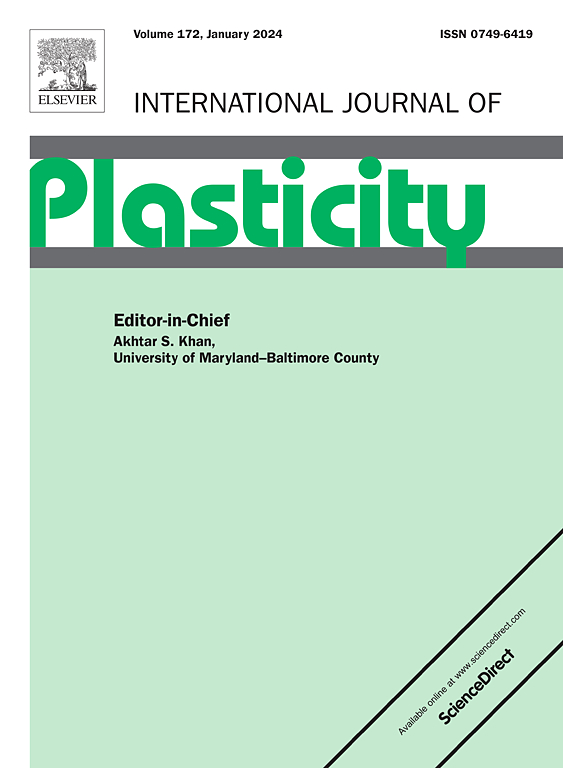Fe-15.5Mn-0.6C-1.4Al钢压缩拉伸高应变硬化及TWIP效应机理探讨
IF 9.4
1区 材料科学
Q1 ENGINEERING, MECHANICAL
引用次数: 0
摘要
本研究探讨了大预压缩变形对高锰钢应变硬化和孪晶诱导塑性(TWIP)效应的影响,解决了传统TWIP钢的一个关键限制,即相对较低的屈服强度。利用先进的非原位电子背散射衍射(EBSD)和透射电子显微镜(TEM),我们揭示了纳米孪晶、高密度位错和亚结构演化在复杂应变路径下增强力学响应的作用。结果表明,大的预压缩显著提高屈服和极限抗拉强度,同时保持伸长率,一种独特的强度-延性协同作用在预应变钢中很少实现。高密度位错和纳米孪晶微观组织网络在显著的预变形下复杂共存,使位错滑移路径复杂化,有助于实现独特的强度-塑性平衡,增强加工硬化能力。应变路径的改变激活了新的变形孪晶,这些变形孪晶通过动态形核引入新的界面,改变了晶体取向,从而增强了材料的位错存储能力,保持了较高的加工硬化率。预压缩诱导的非均质微观结构在拉伸加载过程中表现出显著的异质变形诱导(HDI)硬化,提高了拉伸强度,延迟颈缩,改善了变形稳定性。细晶区(FGs)的交叉滑移促进了位错相互作用,形成了坚固的位错网络,进一步提高了钢的应变硬化能力。最后,提出了一个参数化模型来量化孪晶、晶界(GBs)、位错和hdi硬化在优化预应变钢性能中的协同作用,为不同应变路径加载条件下TWIP钢的行为提供基础理解。这些见解推进了TWIP钢变形的基本原理,支持高性能汽车应用Fe-Mn-C-Al合金的开发。本文章由计算机程序翻译,如有差异,请以英文原文为准。

Mechanistic exploration of high strain-hardening and TWIP effects in Fe-15.5Mn-0.6C-1.4Al steel under compression-tensile loading
This study investigates the effects of large pre-compression deformation on strain-hardening and the twinning-induced plasticity (TWIP) effect in high-manganese steel, addressing a critical limitation of traditional TWIP steels, i.e., relatively low yield strength. Using advanced ex-situ electron backscatter diffraction (EBSD) and transmission electron microscopy (TEM), we reveal the roles of nanotwins, high-density dislocations, and substructure evolution in enhancing the mechanical response under complex strain paths. Results indicate that large pre-compression significantly elevates yield and ultimate tensile strength while preserving elongation, a unique strength-ductility synergy rarely achieved in pre-strained steels. The intricate coexistence of high-density dislocation and nanotwin microstructural networks under significant pre-deformation complicates dislocation slip pathways, contributing to a unique strength-ductility balance and enhancing work-hardening capability. Changes in strain paths activate new deformation twins, which, being dynamically nucleated, introduce new interfaces and alter the crystallographic orientations, thereby enhancing the material's dislocation storage capacity and maintaining a high work-hardening rate. Pre-compression-induced heterogeneous microstructure exhibits significant hetero-deformation-induced (HDI) hardening during tensile loading, enhancing tensile strength, delaying necking, and improving deformation stability. Cross-slip in fine-grained regions (FGs) promotes dislocation interaction and the formation of robust dislocation networks, further improving the strain-hardening capability of the steel. Finally, a parametric model is proposed to quantify the synergetic contributions of twins, grain boundaries (GBs), dislocations, and HDI-hardening in optimizing the properties of pre-strained steel, providing a foundational understanding of TWIP steel behavior under varying strain path loading conditions. These insights advance the fundamental principles governing TWIP steel deformation, supporting the development of high-performance Fe-Mn-C-Al alloys for automotive applications.
求助全文
通过发布文献求助,成功后即可免费获取论文全文。
去求助
来源期刊

International Journal of Plasticity
工程技术-材料科学:综合
CiteScore
15.30
自引率
26.50%
发文量
256
审稿时长
46 days
期刊介绍:
International Journal of Plasticity aims to present original research encompassing all facets of plastic deformation, damage, and fracture behavior in both isotropic and anisotropic solids. This includes exploring the thermodynamics of plasticity and fracture, continuum theory, and macroscopic as well as microscopic phenomena.
Topics of interest span the plastic behavior of single crystals and polycrystalline metals, ceramics, rocks, soils, composites, nanocrystalline and microelectronics materials, shape memory alloys, ferroelectric ceramics, thin films, and polymers. Additionally, the journal covers plasticity aspects of failure and fracture mechanics. Contributions involving significant experimental, numerical, or theoretical advancements that enhance the understanding of the plastic behavior of solids are particularly valued. Papers addressing the modeling of finite nonlinear elastic deformation, bearing similarities to the modeling of plastic deformation, are also welcomed.
 求助内容:
求助内容: 应助结果提醒方式:
应助结果提醒方式:


